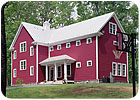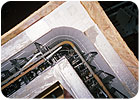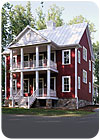
Building a home with concrete - the Romans did it, why shouldn’t we? Though the Romans might have been less concerned with energy efficiency than we are today, they certainly understood the flexibility and durability that building with concrete allows. When it came to building his own home, Doug Lowe, owner and president of Artisan Construction, Inc. in Charlottesville, Va., decided to try insulated concrete forms (ICFs) to get some firsthand experience.
As a central Virginia green builder, Lowe has built with SIPs, Thermasteel panels, advanced framing techniques and modular construction. ICFs seemed like the next technology to experiment with. Achieving ENERGY STAR (www.energystar.gov), Earthcraft (www.earthcrafthouse.com), and LEED for Homes (LEED-H/www.usgbc.org) certifications, his home bolstered the energy efficiency claims made by ICF manufacturers. The home had the tightest envelope (.08 ACH) seen by testers in the area, and was rated by Home Energy Rating Services (HERS) at 94. The HERS rating process evaluates expected annual energy costs in a home. In fact, Lowe’s energy bills since moving into the house eight months ago have been 50-70 percent less than other homes of similar size. He is even showing a 20-30 percent reduction compared to his previous home - and that home had geothermal heating and cooling.
ICFs are a big part of the home’s energy efficiency because they provide such a tight envelope and good insulation, but efficient HVAC systems are the other crucial element. In his home, Lowe decided to condition both the basement and the attic. This dramatic increase in square footage reduced the project’s LEED score by 18 points, but actually increased the efficiency of the HVAC system, decreased its size from 6-8 tons to three tons, and allowed all ductwork to be run in conditioned space. “It was like starting the game 18 points in the hole, but it was the right thing to do from an energy-efficiency standpoint,” says Lowe.

Such a tight envelope was created by the ICFs that special attention needed to be paid to the home’s indoor air quality. Photo by M. Doug Lowe.
Low-/no-VOC finishes and materials are the second part of maintaining indoor air quality in a tight home. All carpets, carpet pads, paints, adhesives and coatings in the home are low-VOC. Other indoor air quality measures in the home include a detached garage, radon protection measures, and a direct-vent gas woodstove.
Reducing a home’s energy footprint first, then considering high-efficiency means of heating and cooling, is the Artisan philosophy. This allows for dramatic reductions in energy consumption in a home, though Lowe and Artisan are currently analyzing the various tradeoffs. Concrete requires a great deal of energy to produce, but is it offset by the energy savings in the home over time? Bamboo is a rapidly renewable material used for flooring and casework, but it requires shipping from China on a CO2-belching cargo ship. (Lowe opted for reclaimed pine flooring from a barn in Pennsylvania for his home.)
“Five, 10 years ago, no one was asking these questions. It was always about the cabinets or the trim; now energy efficiency and indoor air quality are our first concerns with clients,” explains Lowe.
Reducing the energy footprint of a project also extends to demands on public utilities, from the power grid to stormwater management. Lowe’s house features a rainwater collection and filtration system, which supplies the house with 100 percent of its potable water needs, and is capable of processing 60,000 gallons of water a year. No stormwater leaves the site, all plants are native and drought resistant, and demands on local groundwater sources are reduced by using the collection system. Lowe also plans to install PVs on the roof, and a wind turbine in the yard to further reduce the home’s reliance on fossil-fuel energy.
But all of these energy savings begin with a tight envelope. And for this, Lowe found the ICFs indispensable. They were easy for the carpenters to install, they reduced wood scraps generated on the job, and even provided hidden aesthetic benefits too - in the form of 8-inch-deep windowsills.
Artisan will now be adding ICFs to their list of field-tested and proven technologies. With continued monitoring and field research on several upcoming SIP, advanced framing, and ICF projects, Artisan will continue the collaboration, discussion and testing of green and sustainable technologies and methods in the field.

SIDEBAR:lowe residence stats
Location: Crozet, Va.Completed: Spring 2006
Size: 5,500 Square Feet
• Finished Basement – 1,500 Square Feet
• First Floor – 1,600 Square Feet
• Second Floor – 1,600 Square Feet
• Finished Attic – 800 Square Feet
Certifications:
Energy Star
Earthcraft House Virginia
Leed For Homes
Project Team:
Architect: The Gaines Group, Charlottesville, Va.
Builder: Artisan Construction, Inc, Charlottesville, Va.
HVAC Contractor: Albemarle Heating And Air, Charlottesville, Va.
Materials:
Icfs: Amvic Building Systems, Toronto
Concrete: Allied Concrete, Charlottesville, Va.
Rainwater Collection System: Rainwater Management Systems, Salem, Va.
Flooring: The Wood Company, Reclaimed Heart Pine Flooring
Carpet: Mohawk Recycled Pet Carpets; Cri Green Label Carpet Pads
Windows: Weathershield, Double Paned Argon Filled, U Factor = .31; Shgc = .29
Decking: Envirosafe Plus Borate Treated Lumber Forest World Group, Fsc Certified Cumuru
Roof Insulation: Biobased Insulation, Soy-based Insulation
Siding: Hardi Plank

Report Abusive Comment